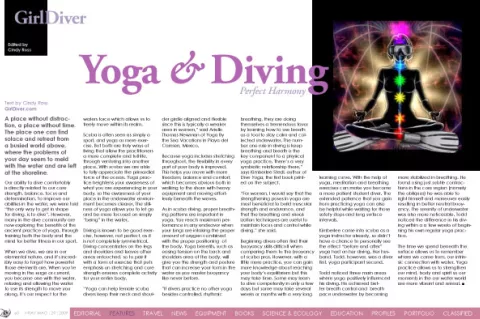A place without distraction, a place without time.
The place one can find solace and retreat from a busied world above, where the problems of your day seem to meld with the water and are left at the shoreline.
Contributed by
Our ability to dive comfortably is directly related to our core strength, balance, focus and determination. To improve our abilities in the water, we were told “the only way to get in shape for diving, is to dive”. However, many in the dive community are now exploring the benefits of the ancient practice of yoga, through training both the body and the mind for better fitness in our sport.
When we dive, we are in our elemental nature, and it’s incredibly easy to forget how powerful those elements are. When you’re moving in the surge or current, you become one with the water, relaxing and allowing the water to use its strength to move you along. It’s our respect for the waters force which allows us to freely move within its realm.
Scuba is often seen as simply a sport, and yoga as mere exercise. But both are truly ways of living that allow the practitioners a more complete and full life, through venturing into another place. With scuba we are able to fully appreciate the primordial force of the ocean. Yoga practice heightens your awareness of what you are experiencing in your body, so the awareness of your place in the underwater environment becomes clearer. The stillness of yoga allows you to let go and be more focused on simply “being” in the water.
Diving is known to be good exercise, however, not perfect, as it is not completely symmetrical. Diving concentrates on the legs and shoulders and leaves other areas untouched, so to pair it with a form of exercise that puts emphasis on stretching and core strength ensures complete activity for your entire body.
“Yoga can help female scuba divers keep their neck and shoulder girdle aligned and flexible since this is typically a weaker area in women,” said Arielle Thomas Newman of Yoga By the Sea Vacations in Playa del Carmen, Mexico.
Because yoga includes stretching throughout, the flexibility in every part of your body is improved. This helps you move with more freedom, balance and comfort, which becomes obvious both in walking to the shore with heavy equipment and moving effortlessly beneath the waves
As in scuba diving, proper breathing patterns are important in yoga. You reach maximum performance in any endeavor when your lungs are intaking the proper amount of oxygen combined with the proper positioning of the body. Yoga benefits, such as easing tension on the back and shoulders area of the body, will give you the strength and posture that can increase your form in the water as you master buoyancy like never before.
”If divers practice no other yoga besides controlled, rhythmic breathing, they are doing themselves a tremendous favor by learning how to use breath as a tool to stay calm and collected underwater. The number one rule in diving is keep breathing and breath is the key component to a physical yoga practice. There’s a very symbiotic relationship there,” says Kimberlee Stedl, author of Dive Yoga, the first book printed on the subject.
“For women, I would say that the strengthening poses in yoga are most beneficial to build muscular strength and endurance, and that the breathing and visualization techniques are useful to maintain focus and control while diving,” she said. Beginning divers often find their buoyancy skills difficult when comparing them to the buoyancy of scuba pros. However, with a little more practice, you can gain more knowledge about reaching your body’s equilibrium but this may take time. Some may learn to dive competently in only a few days but some may take several weeks or months with a very long learning curve. With the help of yoga, meditation and breathing exercises can make you become a more patient student diver. The extended patience that you gain from practicing yoga can also be helpful while waiting for those safety stops and long surface intervals.
Kimberlee came into scuba as a yoga instructor already, so didn’t have a chance to personally see the effect “before and after” yoga had on her diving. Her husband, Todd, however, was a diver first, yoga participant second. Todd noticed three main areas where yoga positively influenced his diving. He achieved better breath control and breath pace underwater by becoming more stabilized in breathing. He found using just subtle contractions in the core region (namely the obliques) he was able to right himself and maneuver easily resulting in better neutral buoyancy. The serenity of underwater was also more noticeable. Todd noticed the difference in his diving within a a few weeks of beginning his own regular yoga practice.
The time we spend beneath the surface allows us to remember where we came from, our intrinsic connection with water. Yoga practice allows us to strengthen our mind, body and spirit so our moments in the our water world are more vibrant and surreal.
Published in
- Log in to post comments


























